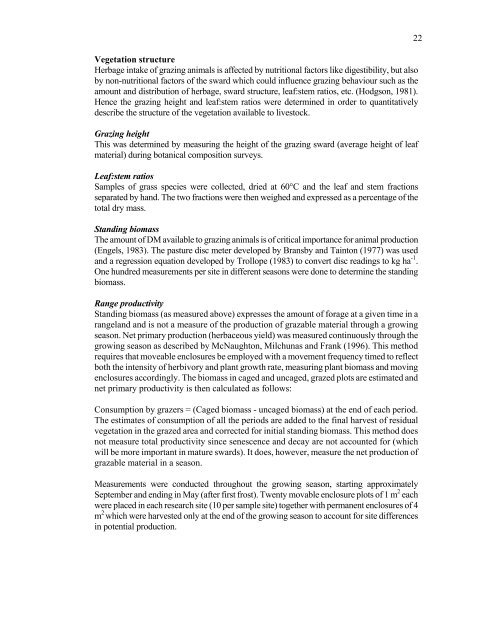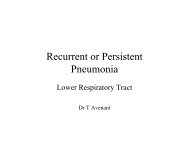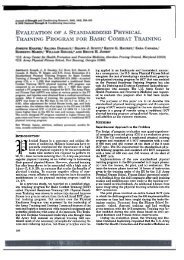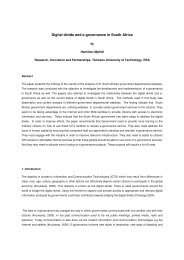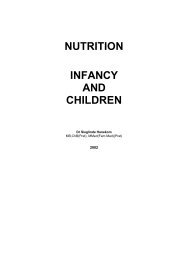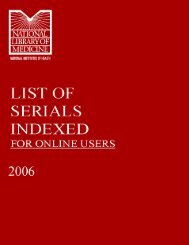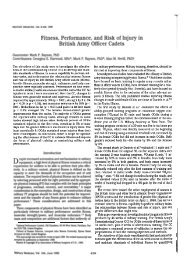Research and Training Strategies for Goat Production Systems in ...
Research and Training Strategies for Goat Production Systems in ...
Research and Training Strategies for Goat Production Systems in ...
Create successful ePaper yourself
Turn your PDF publications into a flip-book with our unique Google optimized e-Paper software.
Vegetation structure<br />
Herbage <strong>in</strong>take of graz<strong>in</strong>g animals is affected by nutritional factors like digestibility, but also<br />
by non-nutritional factors of the sward which could <strong>in</strong>fluence graz<strong>in</strong>g behaviour such as the<br />
amount <strong>and</strong> distribution of herbage, sward structure, leaf:stem ratios, etc. (Hodgson, 1981).<br />
Hence the graz<strong>in</strong>g height <strong>and</strong> leaf:stem ratios were determ<strong>in</strong>ed <strong>in</strong> order to quantitatively<br />
describe the structure of the vegetation available to livestock.<br />
Graz<strong>in</strong>g height<br />
This was determ<strong>in</strong>ed by measur<strong>in</strong>g the height of the graz<strong>in</strong>g sward (average height of leaf<br />
material) dur<strong>in</strong>g botanical composition surveys.<br />
Leaf:stem ratios<br />
Samples of grass species were collected, dried at 60°C <strong>and</strong> the leaf <strong>and</strong> stem fractions<br />
separated by h<strong>and</strong>. The two fractions were then weighed <strong>and</strong> expressed as a percentage of the<br />
total dry mass.<br />
St<strong>and</strong><strong>in</strong>g biomass<br />
The amount of DM available to graz<strong>in</strong>g animals is of critical importance <strong>for</strong> animal production<br />
(Engels, 1983). The pasture disc meter developed by Bransby <strong>and</strong> Ta<strong>in</strong>ton (1977) was used<br />
<strong>and</strong> a regression equation developed by Trollope (1983) to convert disc read<strong>in</strong>gs to kg ha -1 .<br />
One hundred measurements per site <strong>in</strong> different seasons were done to determ<strong>in</strong>e the st<strong>and</strong><strong>in</strong>g<br />
biomass.<br />
Range productivity<br />
St<strong>and</strong><strong>in</strong>g biomass (as measured above) expresses the amount of <strong>for</strong>age at a given time <strong>in</strong> a<br />
rangel<strong>and</strong> <strong>and</strong> is not a measure of the production of grazable material through a grow<strong>in</strong>g<br />
season. Net primary production (herbaceous yield) was measured cont<strong>in</strong>uously through the<br />
grow<strong>in</strong>g season as described by McNaughton, Milchunas <strong>and</strong> Frank (1996). This method<br />
requires that moveable enclosures be employed with a movement frequency timed to reflect<br />
both the <strong>in</strong>tensity of herbivory <strong>and</strong> plant growth rate, measur<strong>in</strong>g plant biomass <strong>and</strong> mov<strong>in</strong>g<br />
enclosures accord<strong>in</strong>gly. The biomass <strong>in</strong> caged <strong>and</strong> uncaged, grazed plots are estimated <strong>and</strong><br />
net primary productivity is then calculated as follows:<br />
Consumption by grazers = (Caged biomass - uncaged biomass) at the end of each period.<br />
The estimates of consumption of all the periods are added to the f<strong>in</strong>al harvest of residual<br />
vegetation <strong>in</strong> the grazed area <strong>and</strong> corrected <strong>for</strong> <strong>in</strong>itial st<strong>and</strong><strong>in</strong>g biomass. This method does<br />
not measure total productivity s<strong>in</strong>ce senescence <strong>and</strong> decay are not accounted <strong>for</strong> (which<br />
will be more important <strong>in</strong> mature swards). It does, however, measure the net production of<br />
grazable material <strong>in</strong> a season.<br />
Measurements were conducted throughout the grow<strong>in</strong>g season, start<strong>in</strong>g approximately<br />
September <strong>and</strong> end<strong>in</strong>g <strong>in</strong> May (after first frost). Twenty movable enclosure plots of 1 m 2 each<br />
were placed <strong>in</strong> each research site (10 per sample site) together with permanent enclosures of 4<br />
m 2 which were harvested only at the end of the grow<strong>in</strong>g season to account <strong>for</strong> site differences<br />
<strong>in</strong> potential production.<br />
22


